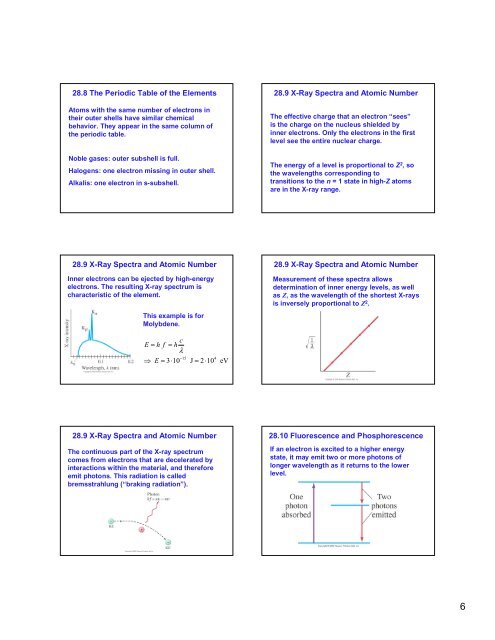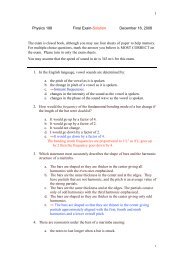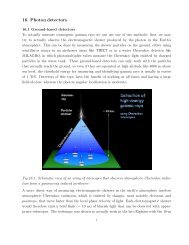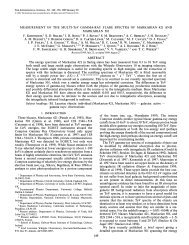Chapter 28 Quantum Mechanics of Atoms
Chapter 28 Quantum Mechanics of Atoms
Chapter 28 Quantum Mechanics of Atoms
You also want an ePaper? Increase the reach of your titles
YUMPU automatically turns print PDFs into web optimized ePapers that Google loves.
<strong>28</strong>.8 The Periodic Table <strong>of</strong> the Elements<br />
<strong>Atoms</strong> with the same number <strong>of</strong> electrons in<br />
their outer shells have similar chemical<br />
behavior. They appear in the same column <strong>of</strong><br />
the periodic table.<br />
Noble gases: outer subshell is full.<br />
Halogens: one electron missing in outer shell.<br />
Alkalis: one electron in s-subshell.<br />
<strong>28</strong>.9 X-Ray Spectra and Atomic Number<br />
The effective charge that an electron “sees”<br />
is the charge on the nucleus shielded by<br />
inner electrons. Only the electrons in the first<br />
level see the entire nuclear charge.<br />
The energy <strong>of</strong> a level is proportional to Z 2 , so<br />
the wavelengths corresponding to<br />
transitions to the n = 1 state in high-Z atoms<br />
are in the X-ray range.<br />
<strong>28</strong>.9 X-Ray Spectra and Atomic Number<br />
Inner electrons can be ejected by high-energy<br />
electrons. The resulting X-ray spectrum is<br />
characteristic <strong>of</strong> the element.<br />
This example is for<br />
Molybdene.<br />
<strong>28</strong>.9 X-Ray Spectra and Atomic Number<br />
Measurement <strong>of</strong> these spectra allows<br />
determination <strong>of</strong> inner energy levels, as well<br />
as Z, as the wavelength <strong>of</strong> the shortest X-rays<br />
is inversely proportional to Z 2 .<br />
c<br />
E = h f = h<br />
λ<br />
−15<br />
E = 3⋅10<br />
J = 2⋅10<br />
4<br />
eV<br />
<strong>28</strong>.9 X-Ray Spectra and Atomic Number<br />
The continuous part <strong>of</strong> the X-ray spectrum<br />
comes from electrons that are decelerated by<br />
interactions within the material, and therefore<br />
emit photons. This radiation is called<br />
bremsstrahlung (“braking radiation”).<br />
<strong>28</strong>.10 Fluorescence and Phosphorescence<br />
If an electron is excited to a higher energy<br />
state, it may emit two or more photons <strong>of</strong><br />
longer wavelength as it returns to the lower<br />
level.<br />
6







